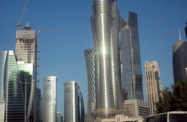Stability and consolidation were Qatar’s watchwords in 2016, as the government continued to make long-term investments in national infrastructure at a time of restricted economic growth in the region.

Marked improvements
In its October 2016 “World Economic Outlook” report, the IMF forecast that Qatar’s GDP growth for the year would come in at 2.6%, down from 3.7% in 2015, as high state spending continued in a wider context of lower energy prices.
Looking ahead, however, the government’s strong policy direction and leadership look set to pay dividends, with the IMF anticipating real GDP expansion of 3.4% in 2017, the highest rate in the GCC.
Significant public spending will continue in 2017, as the government seeks to ensure a number of major infrastructure projects are completed on time.
The 2017 budget, announced in December by the Ministry of Finance, allocates QR93.2bn ($25.6bn) for major projects, maintaining spending in key areas such as health, education and transport.
According to the minister of finance, Ali Shareef Al Emadi, this would include QR46.1bn ($12.7bn) on new projects to be signed in the coming year, split between infrastructure and transportation programmes worth QR25bn ($6.9bn), projects related to FIFA World Cup 2022 facilities valued at QR8.5bn ($2.3bn), health and education schemes of QR5.8bn ($1.6bn), as well as QR6.8bn ($1.9bn) of projects in other sectors.
“An increase in the pace of construction activities on various projects will lead to higher allocation for major projects during the coming three fiscal years,” Al Emadi told local media in mid-December.
Total government spending is budgeted to reach QR198.4bn ($55.5bn) for 2017.
This investment strategy is supporting an increasingly diversified economy, with non-oil growth figures reaching 7.8% in 2015 and 5.8% in the first half of 2016, well above the country’s overall GDP growth recorded for the year.
Maintaining spending, however, will result in a budget deficit of QR28.3bn ($7.8bn), down 39.1% on the budgeted deficit for 2016. Given Qatar’s recent history of high oil revenues, this would be the country’s second budget deficit in 15 years.
Greater worker protection
Ongoing state initiatives include easing regulations for Qatar’s largely migrant workforce, something that has become a point of contention in recent years. In mid-December, the government announced that it had lifted the controversial kafala (sponsorship) labour legislation.
Under the kafala system, migrant labourers were allowed to leave Qatar only with permission from their employers, and workers who left a job at the end of the contract were required to wait at least two years before returning to the country for employment by another company.
Kafala has now been replaced by a new system, which the minister of labour, Essa bin Saad Al Naimi, called “a modernised, contract-based system that safeguards workers’ rights and increases job security.”
As a result, foreign workers in the country no longer need sponsorship to change jobs or leave the country. Employers who confiscate passports, blocking the rights of employees from leaving the country, will be fined QR25,000 ($6800), up from QR10,000 ($2700) under the previous system.
The new law also provides a grievance committee for cases in which sponsors refuse to grant exit visas.
Strong year for Islamic banking
Qatar’s financial services sector performed strongly in 2016, with Islamic banking in particular recording high growth. Sharia-compliant banking grew by 7.2% in the first half of 2016 while the conventional side of the sector increased by 6.5%, with ratings agency Fitch attributing the growth figures to higher retail and real estate financing.
Among the industry’s strongest performers was local sharia-compliant investment bank Qinvest, which in November announced a revenue increase of 18% year-on-year in the first nine months of 2016.
However, Fitch expects full-year figures for 2016 to show Islamic banking growth slowing in the second half of 2016, citing reduced hydrocarbons reserves and high government spending.
Elsewhere in banking, following the US Federal Reserve’s December announcement that it was raising its federal funds rate’s target range to 0.5-0.75%, the Central Bank of Qatar (QCB) increased interest rates by 0.25%. This means that the overnight lending rate was raised from 4.5% to 4.75% and the deposit rate went from 0.75% to 1%, as of the middle of December.
The Fed’s rate hike and QCB following suit were both expected. In a recent report, Fitch Group research agency BMI had forecast that Qatar’s 2017 growth meant it would be in a position to withstand the effects of the hike.


